Why before who
Does the customer always come first? Do customer-needs drive everything? For that matter, is the customer always right?
There’s been quite a lot of promotion of such ideas in my Twitter-stream lately, but I kinda have my doubts on all of these… And worse, a real nasty feeling that if we do get this one wrong, in our strategy, our business-model, our customer-journey mapping or whatever, we set ourselves up for a real nasty failure that will be all the nastier because on the surface it seems so much ‘the right thing to do’…
There’s a really simple way to reframe this, but it needs a bit of explanation first.
To start with, let’s take what I’ve previously termed as ‘the reason why anything happens’:
Why anything happens is that there’s a tension between what we want (the desired-ends, aka ‘the vision’) versus what we have (the realised-ends, aka ‘the real-world’). Somewhere along that tension, we decide to do something (the means, typified as ‘the service’) to reach towards those desired-ends.
Or, to put it another way, the tension between vision and real-world provides the ‘Why‘ for the service.
Out of that ‘Why’ also fall various values and principles and suchlike that determine the meaning of ‘success‘ for that service. The values and principles provide metrics and guidance that help us to determine whether our service is more, or less, on-track towards its vision, its desired-ends.
That applies even if we’re working entirely on our own, and the sole recipient for the service is ourselves. In many cases, though, or perhaps most, we share some aspects of that service with others, most visibly in the form of service-provision from others (‘suppliers’), and service-provision to others (‘customers’) – a value-flow:
This gives us the classic ‘business-model’ relationships (as further expanded in modelling-templates such as Business Model Canvas):
Which can be expanded out indefinitely in both directions into a value-web or, more simply, a linear supply-chain of transactions:
Each of these relationships can be mapped out in terms of the classic organisation-centric transaction-cycle:
Yet if we focus only on this horizontal flow of transactions, it’s easy to miss something really important: there’s no ‘Why’ depicted there, other than the implicit ‘Why’ that arises from Who, How and What. This is exactly the reason why so many people misunderstand the nature and role of ‘value-proposition’, describing it as “the fancy name for your product or service”. It’s not: instead, the value-proposition is how we propose to deliver value, first in terms of the vision (the Why), and then in terms of the value-flow between the parties in those transactions (the How and With-What). As Simon Sinek puts it, “start with Why“, before moving on to How and With-What.
We also need to note that the real context of the business-model is much broader than that overly-simplistic single-step supply-chain from supplier to self to customer. In reality, we need to expand our awareness from this:
To something more like this:
And to expand that simplistic transaction-cycle, between each of the players in the supply-chain:
To the complete service-cycle that engages all of the stakeholders in that expanded view of the service-context:
Which we can then crossmap in terms of the focus at each stage of that cycle:
Which zigzags through the various internal-facing and external-facing child-services of the service as a whole:
And for which the enterprise-vision – the shared-Why for all stakeholders in that overall service-context – provides the reason why those stakeholders connect (even if only transitorily) with each other, and with the goals, mission and role of the service whose nominal ‘Why’ this would be:
And how and why those players relate with each other, both ‘vertically’ (vision and values) and ‘horizontally’ (value-flow):
The Why – the story that connects all of those stakeholders – becomes the reason why they are stakeholders in that story. To quote Simon Sinek, Why comes before How comes before What and With-What; yet also, to paraphrase, Why also comes before Who.
Yet let’s jump back to that service-cycle again – and note specifically the way in which those interactions of the cycle will nest within each other:
What this shows us is that, yes, the Who of the customer (‘Respect/relations’) does come before the How and What of our business-model (‘Attention/conversation’ and ‘Transaction/exchange’); and yes, we do need to ensure that the customer is satisfied (‘completion for customer’) before the service-cycle as a whole can be considered complete.
Yet it also shows us that ‘completion for customer’ is not the end of the cycle – in other words, it’s not solely about satisfying the customer. Instead, it’s about ‘completion for all’, providing satisfaction for all stakeholders – including those who are ‘in the story’ even though they may not interact much with us directly, if at all. What this really tells us, in effect, is that, whatever we do, and whomever we do it with, we need to satisfy the shared-Why as much, if not more, than the Who, How and With-What.
As an aside, this also suggests another useful crossmap about the focus within each of the stages of the service-cycle:
- Why: shared-enterprise
- Who: strategy
- How: tactics
- What and With-What: operations
Which, in turn, clarifies another crucial concern for the business-model: the Why, and its concomitant values and principles, provide a means to distinguish between ‘good’ and ‘bad’ customers (and suppliers, too) – the ‘bad-ones’ such as Chris Bird described in a recent Tweet:
- “some customers game the system so that they will benefit (eg get a comped meal) by being wrong. Fire them don’t argue.”
‘Good’ customers, suppliers and others align themselves with the same enterprise-vision, values and principles; ‘bad’ ones don’t, and instead are just along for the ride or for what they can take. We can maybe satisfy a ‘bad’ customer (sort-of: often they’ll be back to try to play us for suckers once more); but in doing so we fail the test for ‘completion for all’ – which breaks the virtuous-cycle of expanding and continually-reaffirming the shared-trust and shared-commitments upon which the overall shared-enterprise will depend. To make it work – and work well for everyone in the shared enterprise-story – we need to use the shared-story’s vision, values and principles to show us how and where and when to engage, and when not to engage, with any purported player in that story.
That’s why that shared-Why is so important: keeping on-track towards it reduces the risk of waste in any form, whether in terms of effort (‘completion of the right task’), profit (‘completion for self’), satisfied transactors (‘completion for customer/supplier’) and the shared-enterprise as a whole (‘completion for all stakeholders’).
Which, in turn, brings us to that “simpler way to frame this” that I promised back at the start of this explanation: in short, that Why comes before Who.
Which tells us that the customer doesn’t come first: the shared-story does.
Which tells us that customer-needs don’t drive everything: the shared-story does, with customer-needs always assessed as ‘relevant’ or ‘not-relevant’ in terms of that story.
And which also tells us that the customer is not always right: at times they may well be wrong, in terms of that story. (Not ‘wrong’ in any supposed-‘absolute’ sense, but simply in context of that story.)
Why comes before Who comes before How comes before What: that order is important.
So if you want you business-model to work well in practice, never forget that Why comes before Who.
Comments, anyone?
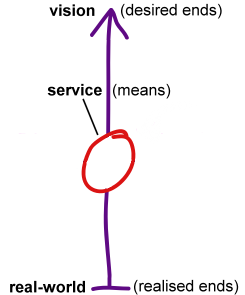
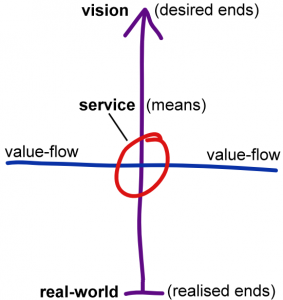


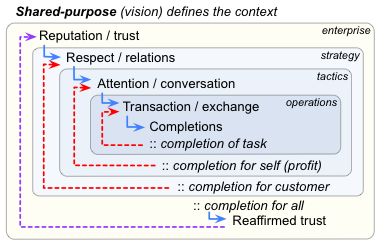
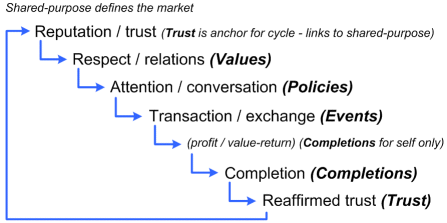
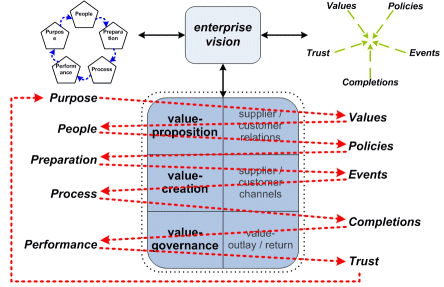
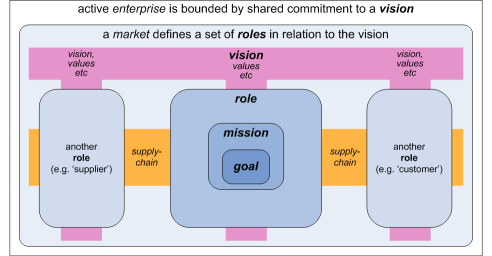
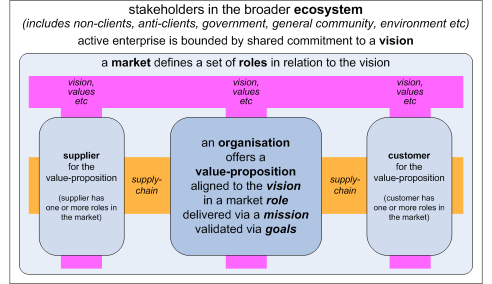
Hey Tom,
I love exploring structures, especially in business, and found your post intriguing. I’ll chew on it for a few more days before I return with (probably) many questions.
Martin
Hey Tom,
You have well explained the significance of “value proposition” and correctly ordered it as
“Why comes before Who comes before How comes before What: that order is important.”
Very good learning for me. It was articulated so nicely that while reading the post I was assuming that we are in live conversation.
I am excited to read all your post and also considering buying the EBook published by you.
You’re welcome, Rakesh – I’m glad it’s useful to you!